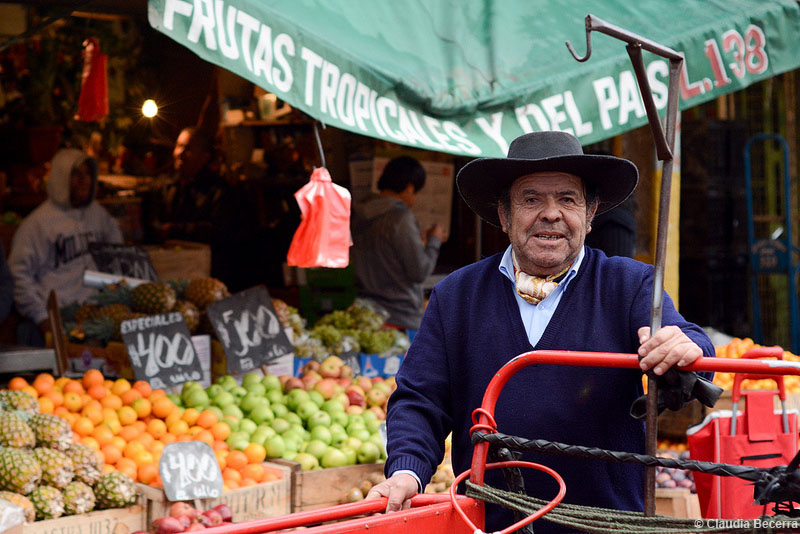Chile is a unique country 2,700 miles long, but on average only 100 miles wide. It ranges from a temperate climate desert in the north, to a Mediterranean central region and a cool, damp south. Yalnız 2.6 percent of its land is arable with another 0.4 percent in permanent crops. Agriculture is specialized for the various climates, like New Zealand, rather than extensive like its large South American neighbors, Argentina and Brazil. Kənd təsərrüfatına aiddir 5.6 percent of GDP and employs 13.2 percent of the work force. Its southern hemisphere location allows it to market fresh fruits to the U.S. and EU in the northern hemisphere winter.
Chile is considered a developing country, but its per capita GDP of $15,500 on a purchasing power parity basis puts it 72th highest in the world, about the same as Russia and Argentina and about one-third of the U.S. ilÉ™ 2010 Chile became the first South American country to join the Organization for Economic Cooperation and Development (OECD), a group of developed and advanced developing countries who seek solutions to common problems. With a population of 16.9 milyon adam, it is a market worth pursuing, but not so large to be able to achieve economies of scale in most manufacturing. Chile gains through two-way trade by selling what it produces best and importing what it cannot produce at low costs.
U.S. merchandise exports to Chile according to Department of Commerce data quadrupled from $2.7 milyard 2003, the last year before the agreement went into effect, qədər $10.9 milyard 2010. Petroleum and coal products topped the list in 2010 at $2.2 billion followed by machinery, except electrical, at $1.9 billion and computer and electronic products at $1.5 milyard. Chemicals at $1.4 billion and transportation equipment at $1.3 billion rounded out the top five categories which accounted for 75 percent of exports. Imports from Chile almost doubled from $3.7 milyard 2003 qədər $7.0 milyard 2010, with primary metals (copper) at $2.7 milyard, 38 percent of the total, and agricultural products at $1.6 milyard, 23 percent of the total.
U.S. agricultural exports to Chile according to the Foreign Agricultural Service of USDA have almost tripled from $151 milyon 2003 qədər $443 milyon 2010. Wheat led at $114 milyon, followed by feeds and fodders at $61 milyon, dairy products at $26 milyon, tree nuts at $22 million and red meat at $17 milyon. Imports from Chile increased from $2.5 milyard 2003 qədər $3.4 milyard 2010, bir 36 faiz artım. Fresh fruit led at $1.4 milyard, followed by fish and seafood at $576 milyon, wine and beer at $278 million and planting seeds at $210 milyon.
The shifts in trade under the FTA have not been a surprise. Before the FTA, Chile had greater access to U.S. markets than the U.S. had to Chilean markets. The EU, Canada and Mexico also had greater access to Chile than the U.S. and the agreement put the U.S. in a preferred position. Customs procedures were also streamlined. On a percentage basis U.S. exports have grown faster because markets are now more open and Chilean personal incomes have been growing more as the country has become aggressive at pursuing specialized exports markets. U.S. has over 18 times as many people as Chile and higher per capita incomes which continue to attract imports from Chile. U.S. dollar has been low relative to the Chilean Peso which has had a role in encouraging U.S. exports to Chile and limited imports to the U.S.
Before the FTA the U.S. had at natural disadvantages in the Chilean market with Argentina, Brazil Paraguay and Uruguay (MERCUSOR countries) closer in miles and being traditional suppliers. Before the FTA neither county recognized the other’s meat inspection system. The agreement at implementation recognized each other’s inspection system, immediately eliminated the 6 percent tariff on pork and phased out over four years the beef tariff. The 6 percent tariff for non-durum wheat, soybeans and meal and cotton was eliminated immediately and the corn 6 percent tariff ended after two years. Chile agreed to treat U.S. grains no less favorably than other importers, including Canada. Chile also agreed to phase out over 12 years its price band protection system for wheat and flour. The 6 percent tariff on dairy products was phased out over four to eight years.
U.S. and Chile have a thriving seed trade of over $200 million of seed coming to the U.S. each year. The Chilean summer season can be used to produce seed, including biotech seed, which can be planted the next spring in the U.S.
Both countries are involved in negotiations for an expanded Trans-Pacific Partnership FTA. Chile is already part of the agreement with New Zealand, Singapore and Brunei to remove all tariffs by 2015. The U.S., Avstraliya, Peru, Vietnam and Malaysia are negotiating with the original four countries on a comprehensive agreement for the nine countries. This would tie Chile and the U.S. more closely together on trade issues. Before the recent earthquake and tsunami, Japan was considering possibly joining the talks as was South Korea.
The U.S.-Chilean trade relationship has been relatively free of disputes compared to other trading partners. Chile was not singled out in the U.S. Trade Representative (USTR) 2010 Report on Technical Barriers to Trade. The 2010 Report on Sanitary and Phytosanitary Measures by the USTR cited issues related to trichinosis in pork and BSE in beef. The President’s 2010 Annual Report on Trade noted that Chile remains on the Priority Watch List for protection of Intellectual Property Rights.
The U.S.-Chile Free Trade Agreement is a reasonable model of benefits for producers and consumers of freer trade for a large country with a much smaller one. Comparative advantage allows the smaller economy to grow more rapidly while some producers and consumers in the larger country also benefit.

